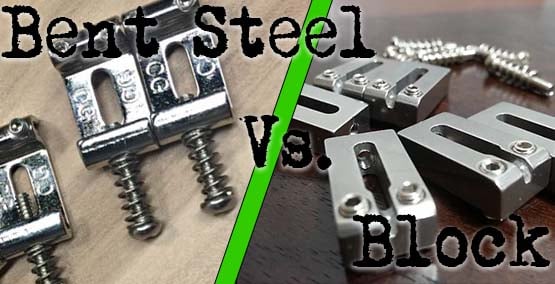|
Did you ever wonder how block saddles sound different from bent steel saddles? Here we took a guitar equipped with cast block saddles and replaced them with vintage-style bent steel saddles, recording the same little phrases before and after the change – two clean, two dirty. Take a listen. You’ll hear each phrase twice: first with the block saddles, then with the bent steel.
|
Control
All else was kept the same: volumes, settings, equipment, the guitar pick, picking position on the strings, even the strings themselves which, listen, was a total hassle, but important because new strings are bright and brands differ.
Tone
The greatest difference is in the unplugged sound; live in the room, the guitar is clearly brighter. But once amplified and recorded, there is still a difference. Listen to the individually picked notes of the chords in the first example and there is a more rounded, fundamental tone with the blocks, and a bit of Strat-style zing with the bent steel, due to increased harmonics. The second example, a simple E minor chord played on the neck pickup, is perhaps the most obvious, sounding more open and chimey with the new saddles.
The distinctions become less apparent with a dirty tone, but they are there if you listen carefully. The short lead phrase played with the neck pickup is fatter and fuller with the block saddles, but gains a bit of clarity and bite with the bent steel ones. The last piece, a distorted rock riff played on the bridge pickup, sounds nearly identical with both saddle types, though there’s maybe a bit less weight and chunk to the bent steel take.
The distinctions become less apparent with a dirty tone, but they are there if you listen carefully. The short lead phrase played with the neck pickup is fatter and fuller with the block saddles, but gains a bit of clarity and bite with the bent steel ones. The last piece, a distorted rock riff played on the bridge pickup, sounds nearly identical with both saddle types, though there’s maybe a bit less weight and chunk to the bent steel take.
Playing Favorites
Subtle differences, yes, but real and demonstrable. It’s easier to understand why Fender itself has gone back and forth over the years, as if unable to decide: “Are our guitars too twangy and bright? Do we need more fundamental tone? Or is that springy sound our signature?” Easier also to see why vintage purists demand their bent steel, with the differences extending beyond the mechanical and the aesthetic.
Hopefully you now know if the difference matters to you.
Hopefully you now know if the difference matters to you.




